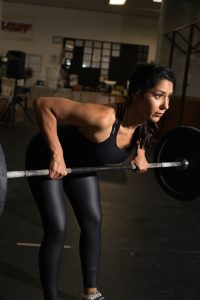After years of training myself and others, I finally learned (sometimes the hard way), that little tweaks here and there in your programming can be the biggest game changer in your fitness. For example, when I started percentage-based training, my strength levels and muscle definition went through the roof. When I switched to sumo deadlifts instead of traditional, I was able to lift more without it bothering my back. Then of course, there was the time that I started training with higher volume less days a week, and my body responded well to it.
Anything from grip to foot positioning can dramatically change the emphasis of an exercise, and it’s one I like to play with often with my 1:1 online coaching clients. Grip in particular can make or break an exercise depending on the individual, and its one minor element that’s grossly overlooked in strength training.
A strong grip helps build resiliency and strength in the upper body, it allows you to lift heavier raw, helps prevent injury of the hand and forearm, and in some cases, emphasizes a different muscle group altogether. But before we dive in, let’s get familiar with three types of grip positions:
- Pronated: The palms face away from the body
- Supinated: The palms face towards the body
- Neutral or Parallel: The palms face each other
Depending on your injury history and goals, one grip in a particular exercise might be more beneficial than the other because it’s safer for your joint or muscle. Or, you may even consider training all three types of grips in an exercise like the pull-up to get all the muscles involved in a slightly different way.
If you want to be the best, strongest, well-rounded version of yourself (and less prone to injury), training multiple grips is worth your time.
Three Exercises, Three Grips
The dumbbell bench press
The parallel grip is the most shoulder friendly grip variation with this exercise, putting a greater emphasis on the chest and triceps without straining the shoulder joint too much. For anyone with a history of shoulder impingement or past shoulder injuries, this is a safer alternative to the traditional wide-grip dumbbell or barbell press variation.
A pronated grip, however, hits the shoulder joint a bit more so I like to de-emphasize this when a new trainee comes along. It’s not wrong, it’s just different, and I like to program this after a client has demonstrated they can press pain-free.
The Pull-up
The pull-up is a tough exercise in and of itself for a lot of people so the first thing we work on is building up overall grip strength using exercises like hangs, farmer’s carries, and Turkish Get-ups for added shoulder stability.
The parallel grip is typically the easiest pull-up variation because it recruits the biceps more. It is my favorite way to train the pull-up for women who are just starting out or simply want to have sexier, more defined arms. Sure, we could do bicep curls and dips but why isolate a muscle when I can target your ass, abs, and arms in one shot?
With that said, the pronated grip pull-up is still a useful exercise to train. It’s harder because the biceps aren’t as involved as in the chin-up, but this variation recruits the back muscles to a much greater degree. Plus, it looks really cool
Assuming you have decent grip and back strength already, you can start training your pull-ups with all the grips available. It’s a good way to emphasize different muscle fibers and get you stronger in all three positions.
The barbell bent over row
We haven’t covered the supinated grip yet and here’s where it comes in. The supinated grip isolates the back muscl es in a great way, and I love it for more advanced clients who really need to build up their back strength for well…everything.
es in a great way, and I love it for more advanced clients who really need to build up their back strength for well…everything.
The pronated grip, however, still has its merits in this exercise. It hits the biceps more and targets the back. Personally, I love this variation for myself because lord knows, I get sick and tired of traditional dumbbell rows and cable rows. A little change like this feels fresh.
Switching it up
Changing your grip each week isn’t a bad thing, but I’d much rather you stick to style for a minimum of four weeks before making adjustments. The only exception is when you feel discomfort or pain during a lift and switching the grip becomes absolutely necessary. Never overlook the details, friends. That’s where the magic lies.

